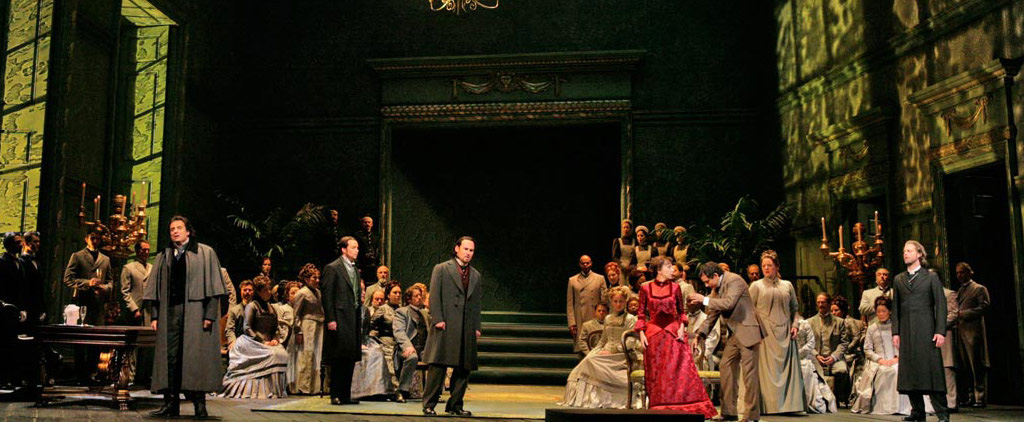Libre
Soutien

A former convent and theatre, the Liceu hasn't always resembled the opera house we see today. Its history is full of ups and downs and mysteries that make this cultural icon a key venue which we invite you to discover on a guided tour of the building. You'll walk through its most representative areas, starting with the historic lobby, in the eclectic Catalan Renaixement style. From there, you'll continue to the auditorium, an exact replica of the impressive horseshoe-shaped hall designed by the architect Miquel Garriga i Roca in 1847. You'll go up to the Hall of Mirrors, an imposing room with a ceiling decorated with allegorical paintings and texts referring to art and music. You'll discover the new foyer, the area where people used to relax during the interval and currently a multi-purpose room which hosts small-scale performances.
MENUS Gran Palace Meat Menu: Mediterranean cream of vegetable soup. Norwegian smoked salmon with baby leafs and sea flavours. Iberian pork sirloin with 5-Pepper sauce, potatoes au gratin and vegetables with a hint of apple. Triple Chocolate ice-cream with berries. Wine and Cava Gran Palace Fish Menu: Mediterranean cream of vegetable soup. Norwegian smoked salmon with fresh lettuce crudité and marinated prawns. Seasonal fish with garnish. Gran Palace cake. Wine and Cava. Gran Palace Vegetarian Menu: Mediterranean cream of vegetable soup (onion, leek, potato and pumpkin). Grilled vegetables with Tofu. Wild rice sauté with mushrooms, and Indian vegetables with stewed piquillo pepper and a pasta crisp. Warm apple cake with vanilla ice-cream. Wine and Cava. Gran Palace Plus Meat Menu: Mediterranean cream of vegetable soup. Norwegian smoked salmon with fresh salad. Beef sirloin with foie and mushroom sauce, potatoes au gratin and vegetables. Warm apple cake with vanilla ice-cream. Wine and Cava. Gran Palace Plus Fish Menu: Pâté or asparagus with mayonnaise. Mediterranean cream of vegetable soup. Norwegian smoked salmon with fresh lettuce crudité and marinated prawns. Seasonal fish with garnish. Gran Palace cake. Wine and Cava. Gran Palace Plus Vegetarian Menu: Mediterranean cream of vegetable soup (onion, leek, potato and pumpkin). Grilled vegetables with Tofu. Wild rice sauté with mushrooms, and Indian vegetables with stewed piquillo pepper sauce and a pasta crisp. Warm apple cake with vanilla ice-cream. Wine and Cava. Menu for Kids: Spaghetti Bolognese. Pork escalope with milanese sauce and fried potatoes. Tulip cookie with Chocolate ice-cream. Please note Benidorm Palace reserve the right to change the menus without notice. *Please note: all the visitors of a group need to choose a menu of the same category (normal or Plus) independently of the main dish chosen (Meat, Fish or Vegeterian).
Experience a classic show when you get tickets to the Off-Broadway debut of this very special performance - Fiddler on the Roof in Yiddish - at ShowTickets.com
Una de las particularidades del Zoo de la Flèche es la diversidad de especies vegetales que alberga, y que contribuyen de forma natural al bienestar de los animales y los visitantes. Consciente de los riesgos que la flora representa para los animales, el Zoo se centra en su preservación y cuenta entre sus paisajes con más de 800 especies de plantas, todas cuidadosamente ubicadas de acuerdo con los ambientes recreados para los residentes del parque. Datos interesantes del zoo: Más de 400.000 de visitantes al año. 18 hectáreas dedicadas a los visitantes 90 toneladas de frutas y verduras al año 1500 animales de 160 especies diferentes 100 personas trabajan todos los días para el bienestar de los animales y el mantenimiento del parque Espectáculos y actividades asegurados durante toda la temporada Cerca de 100 nacimientos de animales por año.
También hay una zona de relajación con una gran piscina dinámica con más de 300 chorros de agua, donde se puede experimentar la experiencia estimulante de un completo circuito termal. La entrada incluye también el uso de una taquilla, y las toallas están disponibles por sólo 2€ con un pequeño depósito. El circuito completo dura dos horas y media. Podrá disfrutar plenamente de un oasis de relajación y salud, y se quedarán impresionados por la calidad del servicio proporcionado por el equipo de profesionales altamente cualificados que le ayudarán a relajarse y recargar las pilas. Hay distintos tratamientos para elegir, pero son opcionales y extras; no se incluyen en Spa.
Airlink 747 You can exchange your 365Tickets voucher at the following exchange points: Travel Information Desk, Arrivals Halls, Terminal 1 Meet and Greet Staff, Airlink Bus Stop, Terminal 1 Bus Driver Dublin Bus Head Office, 59 Upper O'Connell Street **Please note child tickets can only be exchanged with a driver. If you ask a member of staff where your hotel is in regard to the main bus stops they will be more than happy to assist you.
